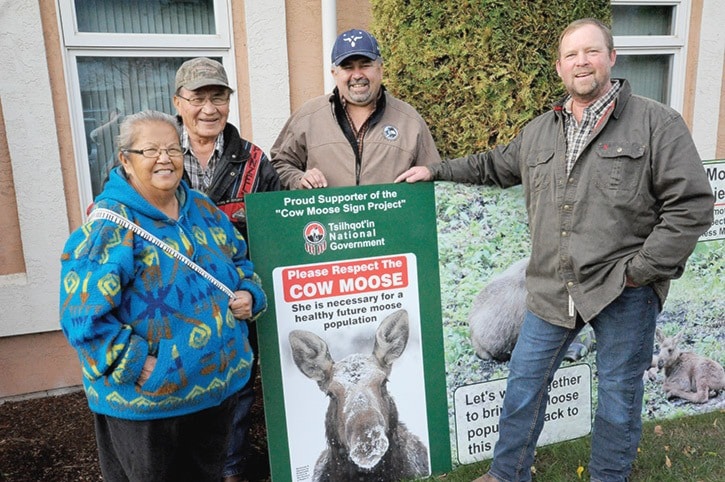Angie Mindus and Monica Lamb-Yorski
Tribune Staff Writers
A non-First Nations hunter and a Tsilhqot’in chief have found common ground in their bid to recover dwindling moose populations.
“We’re honoured to be a part of the (Cow Moose Sign Project) initiative and thank all those who have got involved,” Tsilhqot’in National Government Chair and Chief Joe Alphonse said Thursday before shaking hands with Dan Simmons, creator of the Cow Moose Sign Project.
“We all want to see healthy populations of wildlife, and we all want our grandchildren to see that too.”
Plagued by predation, over-access and poaching, the moose population in Region 5 has seen a dramatic decline in numbers in recent years, according to government studies as well as hunter and First Nations accounts.
Tl’etinqox’t’in (Anaham First Nation) councillor and elder, William Billyboy said his father told him years ago to make sure to look after the moose.
“You have to teach your children how to look after the animals,” William said, with his wife Dinah nodding in agreement.
The couple are spiritual leaders and community elders, and along with Alphonse, are urging everyone, their own people included, not to harvest cow moose.
Alphonse said elders in the community were “disappointed” to learn of First Nations harvesting and selling moose meat in recent years while their community members rely on the meat as a main food source. In the past five years the TNG have been engaged in an education campaign aimed at stopping over-hunting as well as deactivating upwards of 400 roads in the area to block everyone from road hunting.
“When it comes to saving the moose you can’t be prejudice,” he said.
In the past, his community has also worked with the BC Wildlife Federation to bring back trapping courses for the younger generation and promote trapping as a way to manage predator control.
Alphonse said endorsing a program to protect the cow moose fits with First Nations tradition.
“Our traditional laws have always told our members to leave cow moose alone. We want a moose strategy for the Chilcotin region and have been encouraging our own community members to honour those laws.”
Alphonse said industry also needs to do its part in controlling access.
“Industry has a role to play in managing the area,” he said, adding the Tsilhqot’in Nation want to be a part of regulating and enforcing wildlife management in their region.
Simmons, himself a hunter, said he is thrilled to have First Nations support for the Cow Moose Project and has found he has much in common with Alphonse’s views.
“This is really good news. It’s a big step in this project having First Nations involved,” Simmons said.
